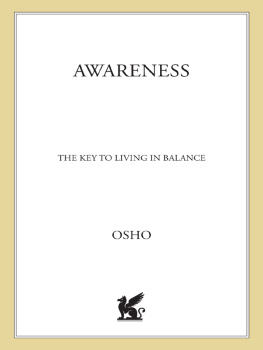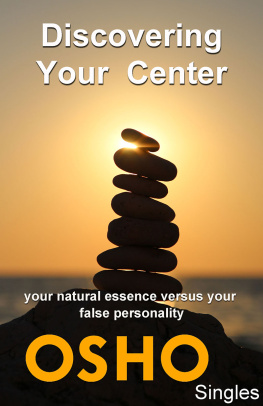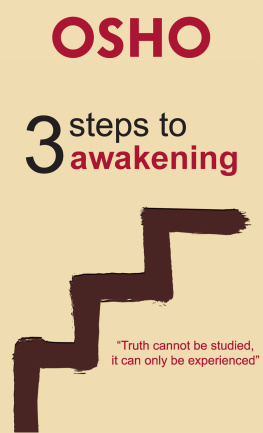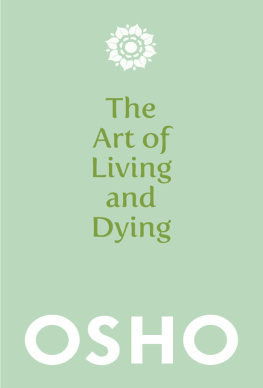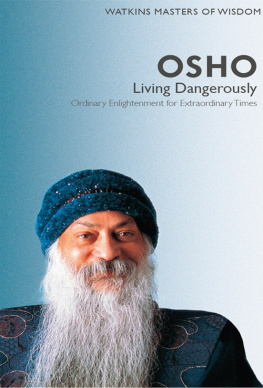The Art of Dying
Published by Jaico Publishing House
A-2 Jash Chambers, 7-A Sir Phirozshah Mehta Road
Fort, Mumbai - 400 001
www.jaicobooks.com
Copyright 1976, 2017 OSHO International Foundation.
All rights reserved
www.osho.com
THE ART OF DYING
ISBN 978-81-8495-966-6
First Jaico Impression: 2017
No part of this book may be reproduced or transmitted in any form or by any means, electronic or mechanical, including photocopying, recording, or by any information storage and retrieval system, without prior written permission from OSHO International Foundation.
The material in this book is a transcript of a series of original OSHO Talks, The Art of Dying , given to a live audience. All of Oshos talks have been published in full as books, and are also available as original audio recordings. Audio recordings and the complete text archive can be found via the online OSHO Library at www.osho.com/library
Photos of Osho: Courtesy OSHO International Foundation
OSHO is a registered trademark of OSHO International Foundation, used under license. www.osho.com/trademarks
THE
ART OF
DYING
EXPLORING THE MYSTERIES OF
LIFE AND DEATH
OSHO
JAICO PUBLISHING HOUSE
AhmedabadBangaloreBhopalBhubaneswarChennai
DelhiHyderabadKolkataLucknowMumbai
Preface
D eath is an illusion. It is always somebody else who dies; you never die. It means death has always been seen from the outside, it is the outsiders view. Those who have seen their inner world are unanimous in saying that there is no death.
You dont know what constitutes your consciousness; it is not constituted of breathing, it is not constituted of heartbeats, it is not constituted of blood circulation. So when the doctor says that a man is dead, it is an outsiders conclusion; all that he is saying is, This man is no longer breathing, his pulse has stopped, his heart is not beating. Are these three things equivalent to death? They are not.
Consciousness is not your body, nor your mind, nor your heart.
So when a person dies, he dies for you, not for himself. For himself he simply changes the house, perhaps moves into a better apartment. But because the old apartment is left, and you are searching for him in the old apartment and you dont find him there, you think the poor guy is dead. All that you should say is, The poor guy escaped. Now where he has gone, we dont know.
In fact, medical science is going beyond its limits when it says that some person is dead. Medical science has no right yet, because it has no definition yet of what constitutes death. It can simply say, This man is no longer breathing. His heart has stopped. His pulse is no longer functioning. To conclude that he is dead is going beyond what you are seeing. But because science does not have any idea of consciousness, the death of the body becomes the death of the being.
Those who have known the being And it is not necessary that you should die and then you know; you can just go inside. Thats what I call meditation just go inside and find out what is your center, and at your center there is no breathing, there is no heartbeat, there is no thought, no mind, no heart, no body, and still you are.
Once a person has experienced himself that he is not the body, not the mind, not the heart, but pure awareness he knows there is no death for him, because he does not depend on the body.
Osho
Beyond Enlightenment
Introduction
E very few thousand years an individual appears who irrevocably changes the world around him in ways that are never immediately apparent, except to the most perceptive.
Osho is one such individual: his spoken words will resonate for centuries to come.
All those words have been recorded and transcribed into books like this one; written words that can carry a transforming message to the reader.
For Osho, all change is individual. There is no society to change it can only happen to each one of us, one at a time. So, no matter what the subject matter of the book, the thread that runs through all Oshos words is like a love song that we can suddenly, mysteriously, hear at just the right moment. And strangely, no matter what the words seem to be referring to, they are really only referring to us.
And this is no ordinary love song; it is more an invitation to open our hearts to hear something beyond the words, beyond the hearta silence beyond all understanding. Where we all belong.
Contents
Know How to Live
When Rabbi Birnham lay dying,
his wife burst into tears.
He said, What are you crying for?
My whole life was only that I might learn how to die.
L ife is in living. It is not a thing, it is a process. There is no way to attain to life except by living it, except by being alive, flowing, streaming with it. If you are seeking the meaning of life in some dogma, in some philosophy, in some theology, that is the sure way to miss life and meaning both.
Life is not somewhere waiting for you, it is happening in you. It is not in the future as a goal to be arrived at, it is herenow, this very moment in your breathing, circulating in your blood, beating in your heart. Whatsoever you are is your life, and if you start seeking meaning somewhere else you will miss it. Man has done that for centuries.
Concepts have become very important, explanations have become very important and the real has been completely forgotten. We dont look to that which is already here; we want rationalizations.
I have heard a very beautiful story:
Some years ago a successful American had a serious identity crisis. He sought help from psychiatrists but nothing came of it, for there were none who could tell him the meaning of life which is what he wanted to know. By and by he learned of a venerable and incredibly wise guru who lived in a mysterious and most inaccessible region of the Himalayas. Only that guru, he came to believe, would tell him what life means and what his role in it ought to be. So he sold all his worldly possessions and began his search for the all-knowing guru. He spent eight years wandering from village to village throughout the Himalayas in an effort to find him. And then one day he chanced upon a shepherd who told him where the guru lived and how to reach the place.
It took him almost a year to find him, but he eventually did. There he came upon his guru, who was indeed venerable, in fact well over one hundred years old. The guru consented to help him, especially when he learned of all the sacrifices the man had made toward this end.
What can I do for you, my son? asked the guru.
I need to know the meaning of life, said the man.
To this the guru replied, without hesitation, Life, he said, is a river without end.
A river without end? said the man in a startled surprise. After coming all this way to find you, all you have to tell me is that life is a river without end?
The guru was shaken, shocked. He became very angry and he said, You mean it is not?
Nobody can give you the meaning of your life. It is your life; the meaning has also to be yours. Himalayas wont help. Nobody except you can come upon it. It is your life and it is only accessible to you. Only in living will the mystery be revealed to you.
The first thing I would like to tell you is: dont seek it any-where else. Dont seek it in me, dont seek it in scriptures, dont seek it in clever explanations they all explain away; they do not explain. They simply stuff your empty mind; they dont make you aware of what is. And the more the mind is stuffed with dead knowledge, the more dull and stupid you become. Knowledge makes people stupid; it dulls their sensitivity. It stuffs them, it becomes a weight on them, it strengthens their ego but it does not give light and it does not show them the way. That is not possible.


![Osho [Osho] The Art of Dying](/uploads/posts/book/114253/thumbs/osho-osho-the-art-of-dying.jpg)
